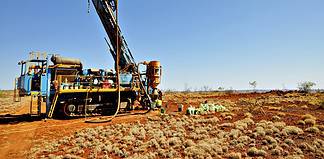A drill rig at Mount Peake mine, under development in the Territory. Image: TNG.
BY ELIZABETH FABRI
THE resources industry has given the Northern Territory’s revised mining royalty plan the thumbs down, claiming a new system will jeopardise future investment and put jobs at risk.
Introduced as part of the 2018 Territory Budget, the new hybrid royalty scheme, effective from 1 July 2019, will force all operating mines to pay increased royalties.
This includes paying the greater of the existing 20 per cent profits-scheme or a minimum value-based royalty on their gross mineral production revenue as soon as they start operating – 1 per cent in a mine’s first year, 2 per cent in its second, and 2.5 per cent in the third and following mineral royalty years.
The decision follows news in early April that the Northern Territory’s share of GST will fall by $136 million next financial year, while all other Australian jurisdictions – except QLD – will see an increase in their GST payments.
It also follows a gold royalty war in WA in 2017 over a proposed increase to royalties, which was subsequently shut down by the Opposition.
Until recently, mineral royalties in the Territory have been collected under the profits-scheme (apart from a few operating under legacy-value-based arrangements), which could essentially be avoided until capital costs of the project were fully absorbed.
Through the scheme, some mines which opened for short periods before closing or entering care and maintenance, paid no royalties.
Glencore’s McArthur River mine reportedly paid no royalties to the Territory Government in 2015 and 2016 as a result of capital investments such as its Phase 3 Development project.
The Territory Government’s decision to change the royalty system was met with opposition from key industry bodies such as the Association of Mining and Exploration Companies (AMEC) and Minerals Council of Australia.
AMEC chief executive Warren Pearce described the royalty increase as an “absolute disaster for the Northern Territory economy”.
“This decision immediately threatens the viability of $6 billion of new mining projects, that would have delivered 4000 new jobs and hundreds of millions in new royalty revenue for the Government,” Mr Pearce said.
“Many of these mining projects will simply no longer go ahead.”
Some of the projects in the planning pipeline included the revival of the Minotaur and Andromeda Metals Rover JV project, TNG’s Mount Peake vanadium-titanium-iron project, and Arafura’s Nolans rare earths and phosphate project.
Mr Pearce said the Territory was already struggling to attract investment and was widely regarded as a “high cost jurisdiction” and the new royalty scheme would make it “one of the most expensive places in the world” to develop a mining project.
Minerals Council of Australia said the new royalty would “add uncertainty and complexity” and “further damage the NT’s attractiveness as an investment destination”.
In 2017, the Northern Territory saw a decline in its score and rank on the Fraser Institute Annual Survey of Mining Companies, sliding to 33rd place out of 91 jurisdictions, compared to 22nd the year prior, attributed to the region’s legal system, infrastructure and availability of labour and skills.
Northern Territory Treasurer Nicole Manison said the royalty changes were all part of a budget repair to address unprecedented fiscal challenges facing the Territory.
“These changes represent a fair and balanced approach to Budget repair, and I thank the Territory business community and other peak bodies for their contribution to the Revenue Discussion Paper,” Ms Manison said.
On 1 May, Northern Territory Resources minister Ken Vowles also announced a new Resourcing the Territory initiative to replace its current Creating Opportunities for Resource Exploration (CORE) program.
Resourcing the Territory will invest $26 million over the next four years; an increase of $2.2 million on the existing program.
“The initiative is designed to make the Territory a preferred destination for resource investment and support local businesses and communities, such as Tennant Creek, that are dependent on the exploration and mining sector for business and employment opportunities,” Mr Vowles said.
“The initiative includes programs to provide immediate stimulus to the sector through industry grants for innovative greenfields exploration, and programs to promote the Territory’s resource potential and attract investment from international markets.”








































